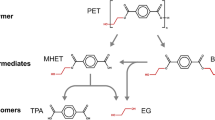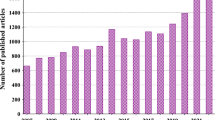Abstract
Dioctyl phthalate (DOP) is industrially commonly used as a polyvinyl chloride (PVC) plasticiser. As DOP does not form a chemical link with PVC, it migrates from flexible PVC segments into the media in contact, a matter that arose concerns due to its noxious effect. Despite the introduction of several non-DOP-based plasticisers recently, most of these new plasticisers are petroleum derived, which is a non-renewable resource. Accordingly, this research aims to produce a natural-based plasticiser using clean production method. Epoxidised 2-ethylhexyl oleate (E-2-EHO) was produced through an esterification and epoxidation reaction between oleic acid and 2-ethyl hexanol; both reactions occur simultaneously, in the presence of hydrogen peroxide as oxygen donor in a solvent-free environment. Candida antarctica lipase (Novozym 435) was used as a cleaner biocatalyst. Several reaction parameters that affect the synthesis of (E-2-EHO) were analysed using response surface methodology based on full factorial central composite design for four variables. The maximum experimental conversion was 94.2% while the value of the predicted conversion was 95.3%. The operation conditions were a temperature of 65 °C, enzyme load of 4 wt%, alcohol-to-oleic acid molar ratio of 4:1, hydrogen peroxide-to-C=C molar ratio of 0.5:1, molecular sieve/g acid of 0.425 g and reaction time of 2 h. In addition, the plasticising effectiveness of (E-2-EHO) to substitute toxic DOP was studied. Comparison with conventional DOP highlighted that (E-2-EHO) had superior and significantly reduced glass transition temperature (tg) and improved mechanical properties. In the proposed study, (E-2-EHO) was proved to be an efficient substitute to DOP by replacing up to 80% of the total plasticiser. Moreover, the product yield obtained in a short time reaction along with the proven stability of Novozym 435 during operation both showed that this ecofriendly and maintainable alternative is favourable when used in large-scale applications.
Graphic abstract










Similar content being viewed by others
References
Abdelmoez W, Mustafa A (2014) Oleochemical industry future through biotechnology. J Oleo Sci 70:68–77
Abdelmoez W, Mostafa NA, Mustafa A (2013) Utilization of oleochemical industry residues as substrates for lipase production for enzymatic sunflower oil splitting. J Clean Prod 59:290–297
Akhanazarova S, Kafarov V (1982) Experiment optimization in chemistry and chemical engineering. Mir Publishers, Moscow, pp 151–158
Azócar L, Navia R, Beroiz L, Jeison D, Ciudad G (2014) Enzymatic biodiesel production kinetics using co-solvent and an anhydrous medium: a strategy to improve lipase performance in a semi-continuous reactor. New Biotechnol 31:422–429
Bankole KS, Aurand GA (2014) Kinetic and thermodynamic parameters for uncatalyzed esterification of carboxylic acid. Res J Appl Sci Eng Technol 7(22):4671–4684
Bansode SR, Hardikar MA, Rathod VK (2017) Evaluation of reaction parameters and kinetic modelling for Novozym 435 catalysed synthesis of isoamyl butyrate. J Chem Technol Biotechnol 92:1306–1314
Brydson JA (1982) Plastics materials, 4th edn. Butterworth Scientific, London, pp 73–85
Chen J, Li K, Wang Y, Huang J, Nie X, Jiang J (2017) Synthesis and properties of a novel environmental epoxidized glycidyl ester of ricinoleic acetic ester plasticizer for poly (vinyl chloride). Polymers 9(12):640
Chowdhury A, Mitra D (2015) A kinetic study on the novozyme 435-catalysed esterification of free fatty acids with octanol to produce octyl esters. Am Inst Chem Eng Biotechnol Prog 31:1494–1499
Federica C, Marcella F, Giuseooe L (2011) Physical–chemical assessment of di-(2-ethylhexyl)-phthalate leakage from poly(vinyl chloride) endotracheal tubes after application in high risk newborns. Int J Pharm 409:57–61
Feng G, Hu L, Ma Y, Jia P, Hu Y, Zhang M, Liu C, Zhou Y (2018) An efficient bio-based plasticizer for poly (vinyl chloride) from waste cooking oil and citric acid: synthesis and evaluation in PVC films. J Clean Prod 189:334–343
Frankel EN, Tarassuk NP (1959) Inhibition of lipase and lipolysis in milk. J Dairy Sci 42(3):409–419
Garlapati VK, Kant R, Kumari A, Mahapatra P, Das P, Banerjee R (2013) Lipase mediated transesterification of Simarouba glauca oil: a new feedstock for biodiesel production. Sustain Chem Process 1(11):1–6
Haigh KF, Vladisavljević GT, Reynolds JC, Nagy Z, Saha B (2014) Kinetics of the pre-treatment of used cooking oil using Novozyme 435 for biodiesel production. Chem Eng Res Des 92:713–719
Hills G (2003) Industrial use of lipases to produce fatty acid esters. Eur J Lipid Sci Technol 105:601–607
Larsson K, Lindh CH, Jönsson BA, Giovanoulis G, Bibi M, Bottai M, Bergströma A, Berglund M (2017) Phthalates, non-phthalate plasticisers and bisphenols in Swedish preschool dust in relation to children’s exposure. Environ Int 102:114–124
Lerin L, Ceni G, Richetti A, Kubiak G, Oliveira JV, Toniazzo G, Treichel H, Oestreicher EG, Oliveira D (2011) Successive cycles of utilization of Novozyme 435 in three different reaction systems. Braz J Chem Eng 28:181–188
Liu T, Jiang P, Liu H, Li M, Dong Y, Wang R, Wang Y (2017) Performance testing of a green plasticizer based on lactic acid for PVC. J Polym Test 61:205–213
Martins AB, Graebin NG, Lorenzoni ASG, Frenandez-Lafuente R, Ayub MAZ, Rodrigues RC (2011) Rapid and high yields of synthesis of butyl acetate catalyzed by Novozym 435: reaction optimization by response surface methodology. Process Biochem 46:2311–2316
Montgomery DC (2000) Design and analysis of experiments, Ch 6, Ch 8, Ch 11, 5th edn. Wiley, New York, USA
Mustafa A, Karmali A, Abdelmoez W (2016) Optimisation and economic assessment of lipase-catalysed production of monoesters using Rhizomucor miehei lipase in a solvent-free system. J Clean Prod 137:953–964
Nihul PG, Mhaske ST, Shertukde VV (2014) Epoxidized rice bran oil (ERBO) as a plasticizer for poly(vinyl chloride) (PVC). Iran Polym J (Engl Ed) 23:599–608
Omrani I, Ahmadi A, Farhadian A, Shendi HK, Babanejad N, Nabid MR (2016) Synthesis of a bio-based plasticiser from oleic acid and its evaluation in PVC formulations. J Polym Test 56:237–244
Orellana-Coca C, Billakanti JM, Mattiasson B, Hatti-Kaul R (2007) Lipase mediated simultaneous esterification and epoxidation of oleic acid for the production of alkylepoxystearates. J Mol Catal B Enzym 44:133–137
Pyeon HB, Park JE, Suh DH (2017) Non-phthalate plasticizer from camphor for flexible PVC with a wide range of available temperature. J Polym Test 63:375–381
Regulation (EC) (2008) No 1272/2008 of the European Parliament and of the council. O.J.EU
Shah BL, Shertukde VV (2003) Effect of plasticizers on mechanical, electrical, permanence, and thermal properties of poly(vinyl chloride). J Appl Polym Sci 90:3278–3284
Siódmiak T, Mangelings D, Heyden YV, Borowska MZ, Marszałł MP (2015) High enantioselective Novozym 435-catalyzed esterification of (r, s)-flurbiprofen monitored with a chiral stationary phase. Appl Biochem Biotechnol 175:2769–2785
Tim Somheil Study: Global PVC demand to grow 3.2% annually through 2021. http://www.plasticstoday.com/articles/study-global-PVC-demand-grow-32-annually-through-2021-140811. Accessed 28 June 2015
Törnvall U, Orellana-Coca C, Hatti-Kaul R, Adlercreutz D (2007) Stability of immobilized Candida antarctica lipase B during chemo-enzymatic epoxidation of fatty acids. Enzyme Microb Technol 40:447–451
Unar IN, Soomro SA, Aziz S (2010) Effect of various additives on the physical properties of polyvinylchloride resin. Pak J Anal Environ Chem 11(2):44–50
Véras IC, Silva FAL, Gonzales ADF, Moreau VH (2011) One-step enzymatic production of fatty acid ethyl ester from high-acidity waste feedstocks in solvent-free media. Bioresour Technol 102:9653–9658
Waskitoajia W, Triwulandaria E, Haryonoa A (2012) Synthesis of plasticisers derived from palm oil and their application in polyvinyl chloride. Procedia Chem 4:313–321
Zarejousheghani F, Kariminia H-R, Khorasheh F (2016) Kinetic modelling of enzymatic biodiesel production from castor oil: temperature dependence of the Ping Pong parameters. J Chem. Eng 94(3):512–517
Zhang Z, Zhang W, Zhai ZJ, Chen QY (2007) Evaluation of various turbulence models in predicting airflow and turbulence in enclosed environments by CFD: part 2—comparison with experimental data from literature. HVAC&R Res 13(6):871–886
Zhao X, Qi F, Yuan C, Du W, Liu D (2015) Lipase-catalyzed process for biodiesel production: enzyme immobilization, process simulation and optimization. Renew Sustain Energy Rev 44:182–197
Zheng T, Wu Z, Xie O, Fang J, Hu Y, Lu M, Xia F, Nie Y, Ji J (2018) Structural modification of waste cooking oil methyl esters as cleaner plasticizer to substitute toxic dioctyl phthalate. J Clean Prod 186:1021–1030
Author information
Authors and Affiliations
Corresponding author
Additional information
Publisher's Note
Springer Nature remains neutral with regard to jurisdictional claims in published maps and institutional affiliations.
Appendix
Rights and permissions
About this article
Cite this article
Hosney, H., Al-Sakkari, E.G., Mustafa, A. et al. A cleaner enzymatic approach for producing non-phthalate plasticiser to replace toxic-based phthalates. Clean Techn Environ Policy 22, 73–89 (2020). https://doi.org/10.1007/s10098-019-01770-5
Received:
Accepted:
Published:
Issue Date:
DOI: https://doi.org/10.1007/s10098-019-01770-5






